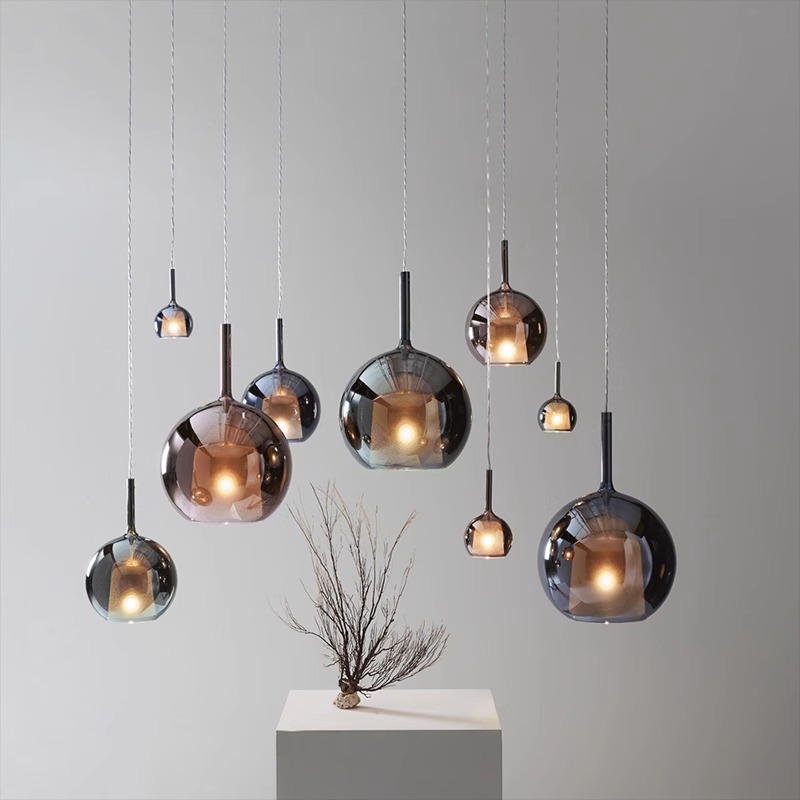Point 1. Comparison of the advantages and disadvantages of common lamp materials
1. Glass

Advantages:
--Good light transmittance: high light transmittance (especially transparent glass), soft and uniform light, suitable for creating a warm atmosphere (such as crystal chandeliers, table lamps).
--High-end texture: polishing or carving technology can enhance the sense of luxury (such as European retro lamps).
--Corrosion resistance: not easy to oxidize, not easy to discolor after long-term use.
Disadvantages:
--Fragile: transportation and installation require extra care, and may hurt people after breaking.
--Heavy weight: large glass lamps need to reinforce the installation structure.
--High cost: Art glass with complex craftsmanship is expensive.
--Applicable scenarios: main lights in the living room, decorative table lamps, high-end hotel lamps.
2. Metal (aluminum, copper, stainless steel, iron art)

Advantages:
--Strong durability: impact resistance, high temperature resistance, long life (especially aluminum alloy has good anti-rust performance).
--Flexible design: strong plasticity, suitable for modern simplicity (aluminum), industrial style (iron art), light luxury (brass) and other styles.
--Good heat dissipation: Metal heat sinks are a common configuration for LED lamps.
Disadvantages:
--Easy to conduct electricity: Strict insulation treatment is required, and safety requirements are high.
--Cold and hard feeling: A soft light cover or warm light source is required to neutralize the cold feeling.
--Oxidation risk: Iron art is prone to rust and requires electroplating or baking paint.
--Applicable scenarios: Track spotlights, downlights, LOFT style chandeliers.
3. Acrylic (PMMA)

Advantages:
--Lightweight and safe: The weight is only 50% of glass, not easy to break, and suitable for children's room lamps.
--Various colors: Can be dyed or UV printed with patterns, with a high degree of customization.
--Soft light transmission: Frosted acrylic can effectively reduce glare and is suitable for office lighting.
Disadvantages:
--Easy to scratch: The surface hardness is low, and a soft cloth is required for cleaning.
--Poor heat resistance: Long-term high temperature may cause deformation (need to stay away from high-power light sources).
--Cheap feeling: Low-quality acrylic is easy to show plastic feeling, and high light transmission models need to be selected.
--Applicable scenarios: ceiling lamps, light strip diffusers, creative shaped lamps.
Point 2. How do environmentally friendly materials improve sustainability?
1. Environmentally friendly material selection
Recycled materials: such as recycled glass and recycled aluminum (reduce energy consumption in mineral mining).
Natural materials: bamboo weaving, wooden lamps (FSC certification is required to avoid deforestation), but fireproofing is required.
Bio-based plastics: PLA materials derived from corn starch replace traditional plastics.
2. Sustainable design
Modular structure: convenient for partial replacement of damaged parts (such as replacing lampshades alone instead of the entire lamp).
Long-life design: with universal standard interfaces (such as E27 lamp sockets), avoid overall disposal of lamps after elimination.
3. Production and recycling
Clean energy: The factory uses solar/wind energy to reduce carbon footprint.
Detachable structure: mark the material classification symbols to facilitate user recycling (such as separation of metal and plastic).
3. User purchase suggestions
Pay attention to safety: acrylic or silicone materials are preferred for children's rooms, and rust-proof metal is selected for kitchens.
Style matching: Nordic style is suitable for logs + acrylic, industrial style uses iron + exposed light bulbs.
Environmental certification: Check whether there are RoHS (no hazardous substances), Energy Star and other logos.
Contact: Mrs Mia
Phone: +86 15767173357
E-mail: info@miaogelighting.com
Whatsapp:+86 15767173357
Add: 3rd Floor, No. 9, Shengfeng Street, Meiliwei Industrial Zone, Guzhen Town, Zhongshan City, Guangdong Province
We chat
